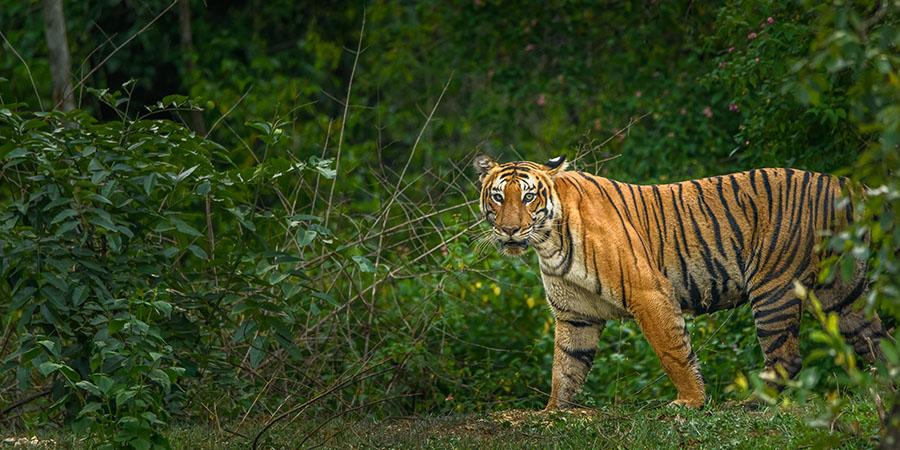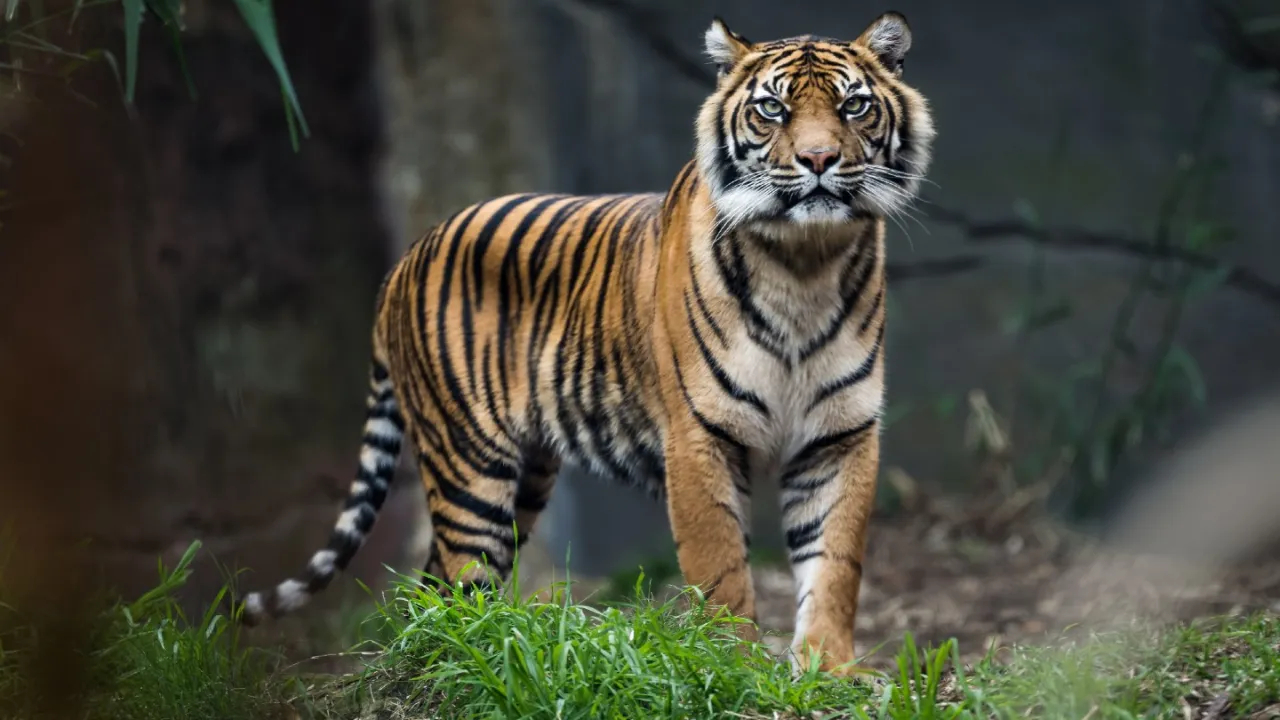Soliga Tribe and Tiger Conservation

- 26 Feb 2025
In News:
In the 119th edition of Mann Ki Baat, Prime Minister Narendra Modi lauded the Soliga tribe of the BiligiriRanganathaswamy Temple (BRT) Tiger Reserve in Karnataka for their significant role in tiger conservation and sustainable forest practices.
Who are the Soligas?
- Location: Indigenous, forest-dwelling tribe residing primarily in Chamarajanagar district, Karnataka, and parts of Tamil Nadu, especially around Biligiri Rangana Hills and Male Mahadeshwara Hills.
- Meaning of the Name: "Soliga" translates to “children of bamboo”, symbolizing their deep ecological ties.
- Language: They speak Sholaga (a Dravidian language), along with Kannada and Tamil.
- Lifestyle:Soligas live in bamboo-and-mud huts, practice shifting cultivation, and depend on non-timber forest produce (NTFP) for sustenance.
- Diet & Livelihood:Honey is a staple in their diet; they extensively forage and harvest forest produce like amla, gooseberries, and medicinal herbs, leaving a portion for wildlife—a reflection of their conservation ethos.
Religious and Cultural Practices:
- Soligasworship wildlife, especially the tiger, locally called “DoddaNayi” (Great Dog). They have even built temples dedicated to tigers.
- Their belief system includes Hindu customs, animism, and naturism, highlighting their spiritual connection with nature.
- They produce eco-friendly artifacts like ‘jottai’ (leaf cups), showcasing sustainable craftsmanship.
Recognition of Forest Rights:
- In 2011, Soligas became the first tribal community in India to receive legal recognition of their forest rights within a tiger reserve, under the Forest Rights Act (FRA).
- This ruling allowed them to reside within the BRT Tiger Reserve and sustainably collect forest produce without displacing wildlife.
Role in Tiger Conservation:
- Soligas’ traditional knowledge of forest ecology helps them coexist peacefully with wildlife, minimizing human-animal conflict.
- They assist the Forest Department in fire prevention, wildlife tracking, and ecological management.
- Their cultural practices ensure minimal disturbance to wildlife. For instance, during harvest, they intentionally leave 25–33% of the produce in the forest for animals.
BiligiriRanganathaswamy Temple (BRT) Tiger Reserve:
- Location: Chamarajanagar district, Karnataka; lies at the confluence of the Western and Eastern Ghats, forming a critical wildlife corridor.
- Ecosystem: Rich in biodiversity with forest types including:
- Southern Tropical Evergreen
- Semi-Evergreen
- Moist Deciduous
- Flora:Axlewood, Rosewood, Terminalia spp., Indian Gooseberry, Ceylon Oak, Golden Shower Tree.
- Fauna: Tigers, Wild Dogs, Sloth Bears, Sambars, Bison, and endangered species like the Icthyophisghytinosus (Caecilian).
- Cultural Site: Named after Lord Rangaswamy, the reserve houses the Biligiri Temple atop mist-covered hills.
Wildlife Corridors

- 07 May 2024
Why is it in the News?
To revive the population of tigers in Sahyadri Tiger Reserve (STR) — the lone tiger reserve in the Maharashtra western region — the state’s forest department will soon translocate tigers from Tadoba-Andhari Tiger Reserve (TATR) in Chandrapur district.
What are Wildlife Corridors?
- Corridors are essentially habitats and pathways that connect wildlife populations, which are fragmented by human settlements and infrastructure works.
- They are crucial for the long-term survival of the tiger population as they help guard against localised extinctions and ensure the exchange of gene flow, which helps in population diversity.
- Tigers have large home ranges and often travel long distances in search of mates and food.
- In doing so, they make use of these wildlife corridors and cross several human-dominated landscapes.
- The role played by corridors in conservation is a well-established one and has been incorporated into policy decisions as well.
- Mitigation measures such as underpasses, and wildlife crossings are now routinely ordered to safeguard tigers and other wildlife in projects where linear infrastructure projects fragment habitats.
- Litigation, advocacy, and policymaking have all contributed to this.
- The construction of an overpass on the National Highway- 7 to protect the migratory route of tigers underneath between the Kanha and Pench Tiger Reserves is one instance of embedding mitigation measures to protect corridors.
- Tigers routinely use the space beneath the elevated stretch of the highway to cross the forests.
- In 2014-15, the National Tiger Conservation Authority and Wildlife Institute of India (WII) mapped 32 major tiger corridors in the country across four broad tiger landscapes – Shivalik Hills and Gangetic plains, Central India and Eastern Ghats, Western Ghats, and the North East Hills.
Is Translocation the Best Approach for Tiger Recovery?
- Tiger translocation projects have been undertaken in India since 2008.
- Sariska Tiger Reserve, in 2008, and Panna Tiger Reserve, in 2009, have witnessed successful tiger reintroduction and translocation projects.
- There have also been failures and shelving of reintroduction plans, like in the case of Satkosia Tiger Reserve in Odisha, which was the country’s first inter-state translocation project.
- However, before choosing translocation, other available options such as habitat improvement, prey augmentation, strengthening of tiger corridors, and vigilance improvement should be assessed.
- Even after translocations, one must ensure that corridors are strengthened and they are free of major disturbances.
- This will ensure the dispersal of tigers to other source population areas.
Global Tiger Conservation Coalition

- 25 Apr 2024
Why is it in the News?
At the Sustainable Finance for Tiger Landscapes Conference, Bhutan and the Tiger Conservation Coalition pledged to mobilize $1 billion for tiger conservation efforts.
About the Tiger Conservation Coalition:
- The Tiger Conservation Coalition is a group of non-governmental organizations (NGOs) that have worked for many years with partners to conserve tigers.
- It brings together leading tiger biologists and experts in wildlife crime, human-wildlife coexistence, policy, finance, development, and communications with unprecedented alignment on achieving tiger conservation at scale.
- Its member organizations include the Environmental Investigation Agency (EIA), Fauna & Flora, the International Union for Conservation of Nature and Natural Resources (IUCN), Panthera, TRAFFIC, United Nations Development Programme (UNDP), Wildlife Conservation Society (WCS) and World Wide Fund for Nature (WWF).
- It is an independent group of organizations that combines and shares the vast knowledge, on-the-ground experience, and data of its members and partners to support Tiger Range Countries in developing and implementing effective approaches to tiger conservation.
- The Coalition was founded on strong relationships among eminent tiger experts already working together on major tiger assessments, including the latest assessment by the IUCN Red List of Threatened Species released in 2022, and the forthcoming Green Status Assessment, and coalesced around a common vision for tiger recovery.
- By engaging national and local civil society organizations from the region, and continuing to support the Global Tiger Initiative Council and the Global Tiger Forum, the coalition aims to further strengthen partnerships and impactful outcomes for tigers.
- In January 2022, the Tiger Conservation Coalition released its vision for tiger recovery through 2034, the next Year of the Tiger.
- “Securing a Viable Future for the Tiger” presents a set of measurable goals and high-level strategic approaches to achieve the long-term presence of viable and ecologically functional populations of wild tigers.
- Its suggested actions, grounded in the latest science and results, would lead to increasing numbers of tigers secure in current and expanded protected habitats, with distribution and connectivity across their indigenous range.
- Tiger Conservation Coalition members co-developed Tiger Conservation Landscapes 3.0, an integrated habitat modeling system to measure and monitor changes in tiger habitat at range-wide, national, biome, and landscape scales in near real-time.
- This work serves as a model for objective, range-wide, habitat monitoring as countries work to achieve the goals laid out in the 30x30 agenda, the Sustainable Development Goals, and the Kunming-Montreal Global Biodiversity Framework.
NATIONAL TIGER CONSERVATION AUTHORITY (NTCA) (PIB)
- 29 Oct 2023
What is the News ?
The National Tiger Conservation Authority (NTCA) is holding an art exhibition in New Delhi from November 3–5, 2023, titled "Silent Conversation: From Margins to the Center."
Facts About:
- The National Tiger Conservation Authority (NTCA) has been constituted under section 38 L (1) of the Wildlife (Protection) Act, 1972.
- It is a statutory body, established in 2006 under the Ministry of Environment, Forest, and Climate Change (MoEFCC).
Objectives:
- Providing statutory authority to Project Tiger so that compliance with its directives becomes legal.
- Fostering Center-State accountability in Tiger Reserve management by providing a foundation for MoUs with states within the federal structure.
- Including a provision for parliamentary oversight.
- Addressing the livelihood interests of local residents in areas surrounding Tiger Reserves.
- Members of NTCA:
Minister in charge of MoEFCC (as Chairperson),
Minister of State in MoEFCC (as Vice-Chairperson),
Three members of Parliament, the Secretary (MoEFCC), and other members.
